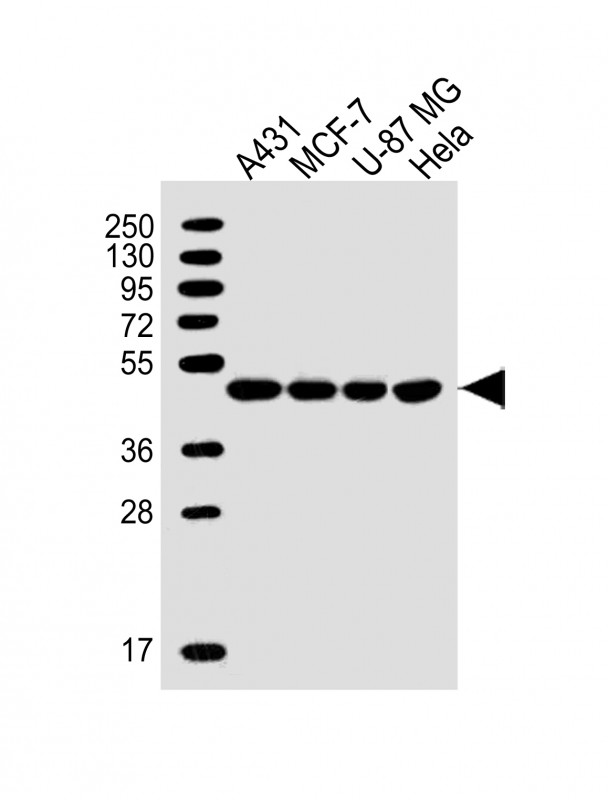KAT1 (HAT1) Antibody (C-term)
Purified Rabbit Polyclonal Antibody (Pab)
- 产品详情
- 实验流程
- 背景知识
Application
| WB |
|---|---|
| Primary Accession | O14929 |
| Reactivity | Human |
| Host | Rabbit |
| Clonality | Polyclonal |
| Calculated MW | 49541 Da |
| Isotype | Rabbit IgG |
| Antigen Source | HUMAN |
| Gene ID | 8520 |
|---|---|
| Antigen Region | 389-419 aa |
| Other Names | Histone acetyltransferase type B catalytic subunit, Histone acetyltransferase 1, HAT1, KAT1 |
| Dilution | WB~~1:2000 |
| Target/Specificity | This KAT1 (HAT1) antibody is generated from rabbits immunized with a KLH conjugated synthetic peptide between 389-419 amino acids from the C-terminal region of human KAT1 (HAT1). |
| Format | Purified polyclonal antibody supplied in PBS with 0.09% (W/V) sodium azide. This antibody is prepared by Saturated Ammonium Sulfate (SAS) precipitation followed by dialysis against PBS. |
| Storage | Maintain refrigerated at 2-8°C for up to 2 weeks. For long term storage store at -20°C in small aliquots to prevent freeze-thaw cycles. |
| Precautions | KAT1 (HAT1) Antibody (C-term) is for research use only and not for use in diagnostic or therapeutic procedures. |
| Name | HAT1 |
|---|---|
| Synonyms | KAT1 |
| Function | Histone acetyltransferase that plays a role in different biological processes including cell cycle progression, glucose metabolism, histone production or DNA damage repair (PubMed:20953179, PubMed:23653357, PubMed:31278053, PubMed:32081014). Coordinates histone production and acetylation via H4 promoter binding (PubMed:31278053). Acetylates histone H4 at 'Lys-5' (H4K5ac) and 'Lys-12' (H4K12ac) and, to a lesser extent, histone H2A at 'Lys-5' (H2AK5ac) (PubMed:11585814, PubMed:22615379). Drives H4 production by chromatin binding to support chromatin replication and acetylation. Since transcription of H4 genes is tightly coupled to S-phase, plays an important role in S-phase entry and progression (PubMed:31278053). Promotes homologous recombination in DNA repair by facilitating histone turnover and incorporation of acetylated H3.3 at sites of double-strand breaks (PubMed:23653357). In addition, acetylates other substrates such as chromatin-related proteins (PubMed:32081014). Also acetylates RSAD2 which mediates the interaction of ubiquitin ligase UBE4A with RSAD2 leading to RSAD2 ubiquitination and subsequent degradation (PubMed:31812350). |
| Cellular Location | [Isoform A]: Nucleus matrix Mitochondrion |
For Research Use Only. Not For Use In Diagnostic Procedures.
Provided below are standard protocols that you may find useful for product applications.
BACKGROUND
Histone acetylation, particularly of histone H4, has been proposed to play an important role in replication-dependent nucleosome assembly. The HAT1 protein contains D, A, and B motifs, which are present in many N-acetyltransferases, including those that acetylate substrates other than histones. The HAT1 holoenzyme consists of 2 subunits: the catalytic 46-kD HAT1 and the accessory p46. The p46 subunit stimulated the activity of HAT1 and bound to core histones. The HAT1 holoenzyme acetylated newly synthesized but not nucleosomal histone H4 at lys5 and lys12, and, to a lesser extent, histone H2A at lys5. HAT1 and p46 polypeptides are located in the nucleus of S-phase cells. HAT1 may play a role in telomeric silencing.
REFERENCES
Gronroos, E., et al., Mol. Cell 10(3):483-493 (2002).
Makowski, A.M., et al., J. Biol. Chem. 276(47):43499-43502 (2001).
Cheung, P., et al., Mol. Cell 5(6):905-915 (2000).
Verreault, A., et al., Curr. Biol. 8(2):96-108 (1998).
终于等到您。ABCEPTA(百远生物)抗体产品。
点击下方“我要评价 ”按钮提交您的反馈信息,您的反馈和评价是我们最宝贵的财富之一,
我们将在1-3个工作日内处理您的反馈信息。
如有疑问,联系:0512-88856768 tech-china@abcepta.com.























 癌症的基本特征包括细胞增殖、血管生成、迁移、凋亡逃避机制和细胞永生等。找到癌症发生过程中这些通路的关键标记物和对应的抗体用于检测至关重要。
癌症的基本特征包括细胞增殖、血管生成、迁移、凋亡逃避机制和细胞永生等。找到癌症发生过程中这些通路的关键标记物和对应的抗体用于检测至关重要。 为您推荐一个泛素化位点预测神器——泛素化分析工具,可以为您的蛋白的泛素化位点作出预测和评分。
为您推荐一个泛素化位点预测神器——泛素化分析工具,可以为您的蛋白的泛素化位点作出预测和评分。 细胞自噬受体图形绘图工具为你的蛋白的细胞受体结合位点作出预测和评分,识别结合到自噬通路中的蛋白是非常重要的,便于让我们理解自噬在正常生理、病理过程中的作用,如发育、细胞分化、神经退化性疾病、压力条件下、感染和癌症。
细胞自噬受体图形绘图工具为你的蛋白的细胞受体结合位点作出预测和评分,识别结合到自噬通路中的蛋白是非常重要的,便于让我们理解自噬在正常生理、病理过程中的作用,如发育、细胞分化、神经退化性疾病、压力条件下、感染和癌症。






